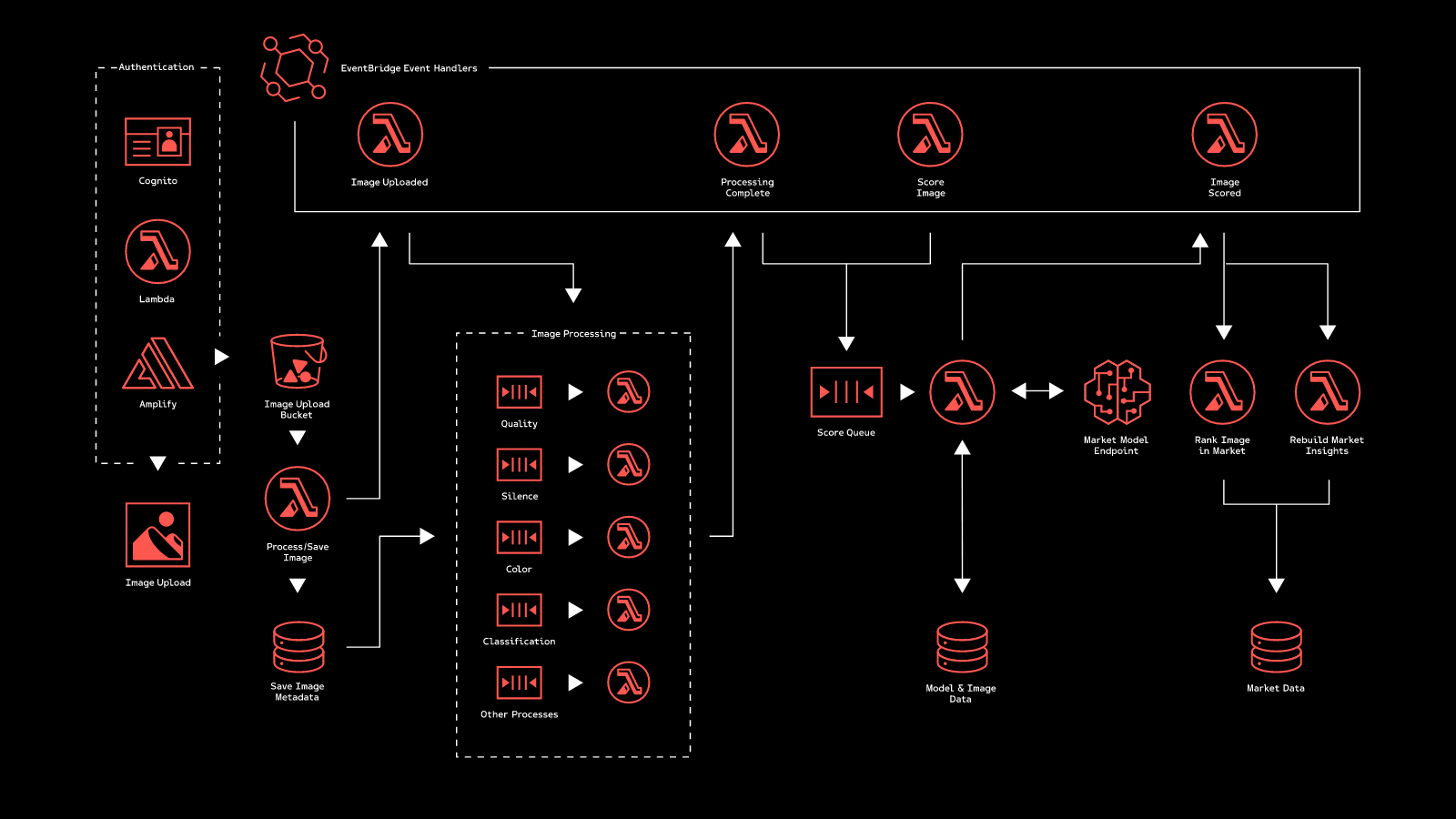The Serverless Backend Architecture model is the most effective way to reduce the cost (financial and time) necessary to design and implement software. It’s also an economical way to host software when it’s meant to run sparingly and certain functions are only utilized frequently. But, development costs aren’t the only expenses during the lifecycle of software.
In fact, the experience shows that bugs and updates after the initial launch can account for up to around 80 percent of the total project costs. Could a serverless architecture help reduce your expenses and cut costs for your project beyond the creation of your software? This kind of architecture doesn’t operate exactly as it seems because apps still require servers.
Architectural designs of the past were usually monolithic and could not be managed in terms of scalability, flexibility, and manageability. Sometimes, all databases were created on the same computer. After spinning everything up, a glitch in one component of this configuration could result in the complete system shutdown and all current operations termination.
This meant that it was a continuous cycle of debugging, programming, or deploying that reduced productivity of the business. Hosting software requires every type of server-related infrastructure. In many past firms, there was only an option of local servers or services by cloud-based providers. Today, both choices have grown to include specifically-focused branches.
Understanding What The Serverless Backend Architecture Entails
Serverless uses the existing managed services available through the public cloud. Not just as a means to host an app but becomes an intrinsic part of it to replace manually configured infrastructure. And sometimes, even entire libraries of code with the managed services. Contrary to what the word “Server-less” would have you think, servers still exist with serverless!
With a serverless development model, developers are able to build, deploy and run applications without having to manage servers. Once deployed, a serverless application will respond to traffic and automatically scale up or down as needed. A web application can be built by using a collection of managed services to provide for all parts of an application.
Such as a service to receive incoming network requests, a computing platform that just accepts code with no maintenance to execute upon those network requests, a fully managed datastore to store and retrieve data, etc. Or even additional services such as object storage to store files, messaging services to allow for queues, pub/sub and streams, and the like.
All with 0 management overhead and pay-per-usage billing. A REST API is the easiest example to provide. Assuming AWS as the cloud vendor, a Serverless REST API consists of API Gateway for receiving HTTP requests, Lambda functions that receive these requests and execute upon them, and DynamoDB as a data store to store and retrieve data from.
Why Should You Go Serverless?
Traditional cloud services, even among the most reputable cloud providers like AWS, IBM Cloud, or Microsoft Azure, do not solve the typical issues local hosting advocates face. Such as the need to maintain local servers, cost inefficiencies, and challenges in scaling. Some complex applications are upgraded and improved by high-performance features and tools, yes.
And, as a result, cloud services can leave massive holes in your financial budget. Fortunately, with serverless backend architecture and cloud technology, it is not the same. For one thing, it permits companies only to pay for resources utilized in the execution of specific functions. If these tasks are not used for one particular time, you don’t have to spend money on them.
However, serverless apps still have the fundamental characteristics of regular cloud-based apps. For instance, server management remains the cloud vendor, while the IT department of the company is solely responsible for the application’s code and the. Ensure that to create a serverless application, it is optional to implement your software completely.
And, you can instead make only a portion or part of the application serverless.
The Most Important Things Before Building The First Serverless Web App
It isn’t possible to use all programming languages in an app development project. But, before starting your first app development using serverless, it is essential to be aware that cloud functions aren’t able to provide support for all the programming languages. Before you start, check which languages you plan to utilize and if App Developers UK supports them.
1. Timeout
There are very few use cases when building applications for the web for which Serverless Backend Architecture is not an option. It all relates to the availability and maturity of managed cloud services. A lot of organizations even apply a hybrid approach where they build as Serverless as they can and fill the gaps with other technologies.
Keep your eyes on the serverless services offered by all vendors that need to be improved for longer-term projects. Therefore, you should maintain a watchdog timer to deal with timeouts.
2. Get yourself prepared for serverless
Serverless applications are only suitable for those familiar with the field, and you’ll need the knowledge to work with serverless effectively. It’s simple to create a “hello world”; however, the efficient application of deployment and monitoring tools requires that you’ve been working with web applications that are in production.
The image above shows the architecture Joot uses for image processing. All of Joot’s users are managed using Cognito to be precise. On the other side, Amplify was used as the library for the web app. While, at the same time, Lambda was used to coordinate user authentication. An image that is saved directly into the S3 when a user comes into the system and uploads.
Triggers set on the image upload bucket go in and then pull that image out, resize it, do some processing and pull meta-data out and store it in DynamoDb.
3. The lambda function requires a lot of configuration
Consider the time needed to configure all functions before you design your project’s timeline. You’ll have to complete the tasks listed below for each task:
- Upgrade the code
- The process of setting up the event
- Making the API endpoint
- The creation of the IAM security role
- Configuring the HTTP request
- Setting up the HTTP response
- The staging endpoint is set up
- The deployment of the API
4. Do not depend on the file system
Don’t store your files on the local file system in an architecture with no server. Since they are ephemeral, servers erase everything once the function has finished. Instead, you should obtain your information from an external source, and you can then process it in your Lambda.
5. Create an online development workflow
If you’re working with a serverless web app, it is possible to face many issues as the setting differs from the typical project. Cloud components run everything, and functions must access and share codes without an all-inclusive solution. To meet these requirements, you must create a successful development workflow known and understood by all team members.
What Is The Best Time To Utilize A Serverless Backend Architecture?
The serverless model is the most effective way to reduce the cost (financial and time) necessary to design and implement software. It’s also an economical way to host software when it’s meant to run sparingly and certain functions are only utilized frequently. Its reliance on triggers makes this architecture the ultimate choice for companies implementing IoT solutions.
Additionally, a serverless design will be more suited to your requirements if you’re an entrepreneur or founder of a startup. Exceptionally, you’ll be able to launch your product more quickly than other strategies to construct infrastructure and significantly reduce your budget since idle servers cost you nothing.
Model for time and money-saving model
Particularly operations and infrastructure management are the responsibility of cloud-based service providers. This lets developers concentrate their efforts on key features of the software. So releases are made more quickly, leading to more rapid feedback from the end users. And, consequently, further enhancements in the upcoming cycle of software releases.
Additionally, since developers do not own the infrastructure behind applications that they run on, they’ve got little to worry about in terms of maintaining, provisioning, and scaling. One of the main reasons to utilize decentralized servers is the automatic scaling and troubleshooting capabilities cloud app development UK providers offer using serverless architectures.
Systems based on serverless architecture are ideal for event processing and low resource-intensive tasks that can scale quickly without the need for dedicated infrastructure, thereby cutting down on the expense of execution.
A serverless design has an impact on accountability and separation of responsibility. For instance, if there is a problem on the server part of the application, the responsibility for fixing the issue is with the cloud provider and not the developer. So, professional application developers don’t have to invest time or resources to resolve the issue.
Some Serverless Architecture Conditions Worth Avoiding
Your app is built with an invariant structure. In particular, we’re talking about software that needs the architecture behind it to be unchanged. Dangerous serverless architectures could be standalone and secure software used for the financial and defense sectors.
Below are a few things to note:
- Your software is tightly connected to your deployment system. Utilization scenarios that require tight coupling with the hardware and the lower level of IT networks. For example, installing specific components, patching, or changing the hard-coding configurations, could also be affected by this update.
- Your application must have low latency when processing incoming requests. While the capabilities of the serverless architecture were intended to improve the speed at the level of systems, this does not mean that all transactions and incoming operations are efficiently processed.
- Another ineffective serverless architecture instance is legacy applications that are yet to move to the cloud. In this scenario, the serverless architecture offers little business value because refactoring code into self-contained parts can be significant in terms of financial expenses, which are higher than the advantages of serverless.
- Your application cannot take into consideration performance limitations. Serverless functions have limitations in terms of speed, capacity, and execution times. In the case of tasks that have a longer duration of execution-such as, for instance, in machine-learning solutions, problems could result from exceeding the limit of time.
Conclusion:
The Serverless Backend Architecture has many advantages for web-based business developers. Such as savings in cost and time, allowing for greater capacity, and even helping lower deployment risks. Whereby, instead of managing and maintaining your application, you can concentrate on writing code, the most critical aspect of developing web-based applications.
But for a newbie programmer, this brings with it some difficulties. However, with an appropriate set of tools and understanding, you can overcome these difficulties and develop web applications and other solutions that have many benefits.
Answers To Frequently Asked Questions:
1. What makes serverless technology superior?
Many developers find that serverless systems allow for greater scalability, flexibility, and faster time to release at a lower cost. Developers who use serverless designs don’t have to think about buying the servers, provisioning them, or managing servers for back-ends.
2. What are the 3 most significant benefits of a serverless design?
The advantages of serverless computing are:
- Cost: You only pay for the services you need to use
- Flexibility: Serverless models scale up without intervention
- Accuracy: Developers can focus on one specific task instead of worrying about the back-end infrastructure that supports this particular action
3. What kinds of applications are serverless computing most suitable for?
The most frequent use of serverless in the present is to support microservices architectures. Microservices are a model that focuses on creating small-scale applications that can perform only one job and interact via APIs.
How is serverless architecture vs microservices different?
This is a false dichotomy. Microservices speaks to how to structure your application at a macro level whereas Serverless describes the interior construction of the application. A Serverless application can use Microservices principles (and is often the recommended approach) and it might not. The microservices in a Microservices architecture may all be built using Serverless, or only some or none.









